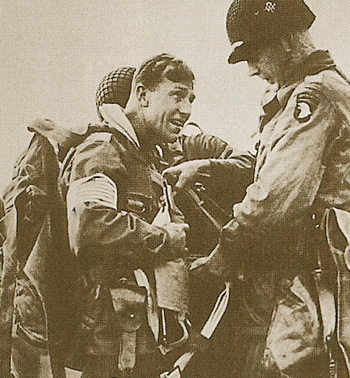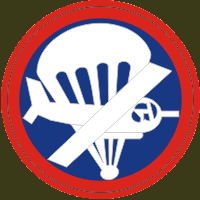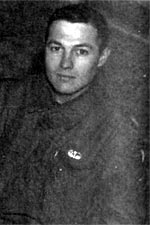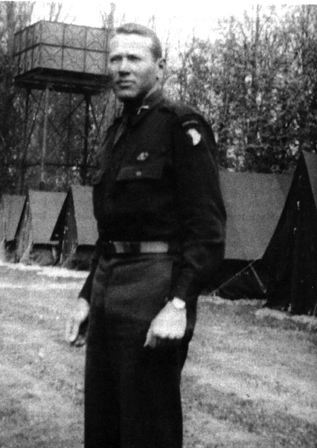|
|
.
501st PIR . Parachute
Infantry Regiment |
|
![]() Roster
Roster
Its origin goes back to June 26th, 1940. At that moment, a group of volunteers coming from the 29th Infantry Regiment gathered to form the first Parachute Test Platoon.
Afterward, this group would obtain the very first regular paratrooper equipment.
The first commander of the 501st was Major William M Miley who would later take command of the 17th Airborne division. This new battalion would instruct the officers for other unit's groups.
The 501st started its training at Camp Toccoa on November 15th, 1942 under the command of Colonel Howard R. Johnson.
 <-Colonel Howard R. Johnson
<-Colonel Howard R. Johnson
If all the members were volunteers, there were only quite a small number who had knowledge of parachute jumping during their training at Toccoa camp.
After this laborious training, the unit was transferred in March 1943 to Fort Benning. At that moment all the members had to be able to jump.
Once their jump training was completed, the regiment was assigned to the Airborne Command at McKall Camp.
It was its last stationing with maneuvers in North Carolina, in Tennessee and in Louisiana.
Eventually, in January 1944, the regiment was sent to Myles Standish Camp, in England. Once in England, the 501st PIR became permanently attached to the 101st Airborne Division and was an essential part of that famous unit for the duration of World War II. Over there, the training became intensified, it was, at the same time, tough and realistic and directed towards the future assault on " Fortress Europe ". Finally, a few days before D-Day, the 501st, as well as all the division, was "held" in a guarded camp where each men learned not only his own mission, but also the ones of the regiment and of the whole division.
In June 1944, the SHAEF decided to send the 82nd and 101st Airborne behind the beaches. The 501st PIR (without his 3rd battalion) took off on June 5th, 1944 at 10:45 p.m. from Merryfield Airport. The 3rd battalion had to leave the same day from Welford. All the devices had to cross the Channel and come down towards the ground once over Normandy, 5 hours before the sea borne landing.
The 501st was going to be dropped to the North and the East of Carantan.
The task of both battalions was the control of the road junction at La Barquette and the destruction of bridges crossing the Douve River while the 3rd battalion stayed in reserve there.
A few hours before the jump, a combination of clouds and AAA resulted in a dispersion of the C-47 formation.
Consequently, the men were seriously scattered, landing far from their DZ (Drop Zone) and were mixed with men of other units. Therefore they had to fight to regroup and to make a success of their mission.
Surprisingly, this "chaos" also confused a lot the Germans.
The success of the mission depended upon the courage and the initiative of each paratrooper, each one having to evaluate his own situation at landing and to decide how to carry out his mission in the best possible way.
For example, the take-over of the main road leading to Utah beach at Poupeville depended upon a group of 100 paratroopers, mainly from the 3rd battalion and Generals Maxwell Taylor and Gerald Higgins, respectively main commander and deputy commander of the division.
On the other hand, some had landed exactly on the enemy lines, where Lieutenant Colonel Robert C. Caroll, commanding the first battalion, was killed and his deputy Major Philip S. Gage was wounded and captured.
Nevertheless Colonel Johnson, having grouped together the men at June 6th nightfall, managed to block the exits of the beaches of his sector as well as the control of the road junction at La Barquette.
Due to its proximity with Carentan, the 101st received the order to take the city. In spite of the fact that the division was not prepared for this new mission, the indomitable spirit of the division, as well as the courage of the men, allowed the full success of this one.
On June 27th, the 83rd Infantry Division came to relieve the 101st, which was sent two days later to relieve the 4th Infantry Division.
The 501st lost during those fights 898 men, killed in action, wounded in action, missing in action or captured.
The 101st then stayed in France as reserve troops till mid-July, when the unit, as well as all the division, was sent to England to re-form. Later, General Eisenhower created the first airborne army consisting of the British, American and also Polish units.
The new army was put to test in September 1944 during Operation
MARKET-GARDEN.

Holland – September 1944 – operation Market-Garden
This plan, created by British Field Marshal Montgomery, would be the first airborne daytime assault on enemy lines since the German’s invasion of Crete.
The plan, similar to the German one, dated September 17th, 1944, foresaw the parachuting of the 82nd and 101st Airborne Division, as well as the 1st British Airborne Division, on the Netherlands, by daytime, with the mission being the take-over and control of the road, the bridges and the main cities which ensured communications between Eindhoven, Nimegen and Arnhem and so facilitate the advance of armored units up to the German border.
The 101st had for its mission the 15 miles defence between the North of Eindhoven and Veghel called also "Hell’s Highway". The 501st had to jump about 4 miles South of Veghel and seize railroad and highway bridges over the Aa River and the Willems Canal. The result was the grip of the first "barrier" on the road of the British tanks towards Arnhem.
 <- Lieutenant Colonel Kinnard
<- Lieutenant Colonel Kinnard
Though Lt Col Kinnard’s 1st battalion wass dropped far from his DZ, the rest of the regiment was dropped in the proper locations and had been able to quickly seize two railroad bridges to the West of Veghel, while two other battalions took undestroyed bridges over the Willems Canal and Aa River.
Then began the most difficult part of the operation, i.e. keeping the way opened by repelling all the German assaults.
Afterward, the 501st as well as the rest of the 101st was moved to the sector of “the island” between the Waal and Rhine River. It appeared very clearly that they would not be removed from the frontline due to their might during the battle.
However, the engagement of airborne divisions in the fight on “the island” was against their use as airborne troop. The fight becomes a static fight, made by patrol.
The fighting became static, with patrols being the sole movement. A war of attrition, under the grapeshot of mortars and shells. The 501st occupied a position between Neder Rijn in Holland and the Rhine River.
On October 8th, 1944, a mortar attack near Heteren wounded Colonel Johnson. Lieutenant Colonel Ewell replaced him. The last words of Colonel Johnson were “Take care of my boys”. With the Colonel, the division lost 661 paras.
At the end of November, the 101st was sent back to Mourmelon, France to rest and to rebuild its force.
On December 16th, 1944, Germans launched their last major offensive, at dawn, by the Ardennes Forest, in the most lightly defended sector. The SHAEF decided on the immediate sending of both American airborne divisions, the 101st being directed towards the strategic city of Bastogne. This city, key of the German offensive, must be held at all costs!
On December 18th, 1944, the 101st was driven towards Bastogne by truck. The 501st was the first unit to arrive on the scene. It reached Bastogne at 10:30 p.m. It headed in the direction of Longvilly, to hold a key road junction beyond the city. It had to fight immediately and hold the German forces to allow time for the rest of the division to join the city. Its first battalion went to Neffe, a few kilometers from Bastogne.
On December 19th at 6:00 a.m., the 501st put itself in movement, first its first battalion, with the 2nd and 3rd battalion maintained in reserve. The B battery of the 81st AAA battalion followed them. After 2 hours of progression, the battalion was stopped by an enemy machine gun on the road leading towards Neffe. The column had to develop from there.
It seemed evident to Lieutenant Colonel Ewell that he would not be able to stop the Panzers attack. He took command of the 2nd Battalion to take Bizory. The take-over of the heights of Bizory gave him the advantage of being able to see enemy movements. This decision contributed very certainly to improve his capacity to resist to the German attacks.
The 2nd Battalion was thus engaged against Bizory by the road to Margeret.
The 3rd Battalion was engaged against the village of Wardin. It met strong resistance and lost in this occasion 45 men and 4 officers. Ewell gave them the order to withdraw, the best way they could. Because of the fights near Wardin, Ewell made the decision to move its defense line.
This new sector crossed Bizory, Neffe and the small village of Mountain.
On December 20th, company F had to push back a combined infantry and panzer attack in the northeast of Bizory. The fights lasted throughout December 21st.
On December 22nd, the 501st was able to detect a lot of enemy movement in the direction of Noville. No change of position between December 23rd and 26th. Sporadic firing, patrols on both sides of the line. On the 23rd, for the first time, an airborne re-supply took place. During this period, the defense line was extended 3km along the road of Bizory, between Mountain and Marvie. To the left we find the paras of the 506th PIR and to the right the troops of the 327th GIR. O'Hara Team was located along the right side.
With the exception of the 3rd Battalion, the losses were not extremely high, considering the kind of defensive operation in which is the 501st was engaged. Only Company I of the 3rd Battalion was overwhelmed at Wardin. The troops were attacked before they had the time to dig trenches. The Regimental HQ was installed in an old school east of Bastogne with, in a nearby chapel, a regimental infirmary. Doctors of the 501st supplied the medical service.
During this period, the activity was mainly patrols to track down the enemy and capture Germans. The soldiers of the patrols were using white bed sheets given by civilians as camouflage. During this period, the weather was icy, the ground frozen, there were snowfalls. The visibility was reduced from 700 to 400 meters. This weather was also to the advantage of the 501st troopers. The Germans overestimated the number of paras! They had to wait for Christmas Day to see the weather get better, allowing allied airplanes to help them.
The paras of the 501st were entrenched along forests whose trees ensured an excellent cover in spite of the danger of bursting woods. This field allowed the Americans to check the intersections leading to Bastogne. Without access to a road, the Germans had no chance to penetrate into Bastogne! The rest of the landscape was covered with snow.
The morale of the troop was always very high and, contrary to the other regiment of the 101st division, it had only moderate losses in fights or during bombardments. The troop did not know that they were encircled till December 24th. Before that, they did not have to suffer too many hardships. They could occasionally observe far off tanks, but they were not able to know if they were German, American or simply destroyed! When the troop received a copy of the answer to the request of surrender, most took that as a joke.
After the first three days of battle, the 501st reserves of food were exhausted. The region being very agricultural, to have at least a warm meal, they used the cattle of the civilians. The German tactics consisting in attacking in several places, but not at the same time, allowed the troop to keep-up but also for the tanks of the American armored support units to be able to intervene at any time wherever the frontline was.
They had to fight against cold and the Germans, waiting for the tanks of Patton to come on December 26th, 1944 to unlock the grip in which the city was.
The 501st PIR paid a price of 580 killed, wounded and missing. Colonel Ewell was badly wounded and relinquished command to Lieutenant Colonel Ballard, who commanded the 2nd battalion from the beginning. He kept the command of the 501st until the end of the war.
 <- Lieutenant
Colonel Ballard
<- Lieutenant
Colonel Ballard
 The End – 1945
The End – 1945
On January 20th, 1945, the division was sent in Alsace where the offensive “Nordwind” had begun under Heinrich Himmler's command. The 501st, with 60 % of its workforce, was sent to Alsace to support the defense of the 7th Army, to occupy defensive positions till it was sent back to Mourmelon, France, in March, 45.
The war approached the end, the 101st was sent to the Ruhr. Then, it was back in France, near Auxerre, to get ready to jump on American POW camps, if the danger which they faced became real. The 501st had to get ready for the invasion of Japan.
On August 25th, 1945, the regiment was removed from the 101st for return to the United States to finally be dissolved at Fort Benning. During all the conflict, the 501st lost 517 parachutists, 1639 wounded and 328 were captured or missing.
United States :
2 Presidential Distinguished Unit Citations for operations in Normandie and Bastogne
France :
War Cross with palms for the Normandy operation
Belgium :
2 War Cross and Lanyards for the Bastogne operations
Holland :
Lanyard Oranje from the Netherlands for the operation Market Garden
